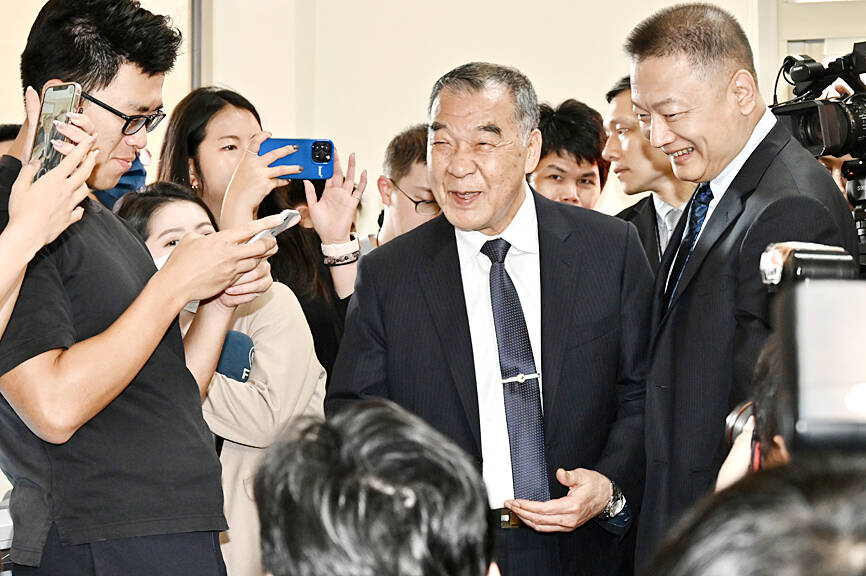Taiwan’s Indigenous Submarine Program would remain on track, Minister of National Defense Chiu Kuo-cheng (邱國正) said yesterday, after the head of the program resigned due to what he said were unfair attacks against him and the military.
Taiwan has made the submarine program a key part of an ambitious project to modernize its armed forces as Beijing stages almost daily military exercises.
Taiwan unveiled the first of eight new submarines in September last year, although it is not expected to enter service until next year.

Photo: George Tsorng, Taipei Times
In a statement late on Tuesday, Admiral Huang Shu-kuang (黃曙光) said that he had resigned as head of the submarine project, as he and the program had been subjected to unfair attacks from people he did not name.
Huang told Reuters that the submarine task force, which includes the navy and shipbuilder CSBC Corp, would continue to operate despite his departure.
“It’s impossible that the team will be disbanded due to one man’s departure,” he said.
Chiu said that Huang is a “conscientious” person, but “members of the task force are all on active duty and can work for a long time. It will not change due to a single personnel change.”
Huang had previously described the submarines as a “strategic deterrent” that could help maintain Taiwan’s “lifeline” to the Pacific by keeping ports along the east coast open.
Taiwan hopes to deploy at least two domestic submarines by 2027, and possibly equip later models with anti-ship missiles.
Chiu yesterday also defended the submarine program and said claims by local media that the costs would soar were “unfair.”
The navy has estimated the cost of constructing the seven vessels over 15 years to be more than NT$280 billion (US$8.62 billion), or about NT$40 billion per vessel.
That is higher than the prototype Hai Kun, which cost about NT$31.2 billion, local media reported.
When asked about the issue by Democratic Progressive Party Legislator Michelle Lin (林楚茵) at a meeting of the legislature’s Foreign Affairs and National Defense Committee yesterday, Chiu said the estimate not only included construction costs, but also expenses related to classified items.
Chinese Nationalist Party (KMT) Legislator Huang Jen (黃仁) also questioned why the cost was expected to rise, quoting Su Tzu-yun (蘇紫雲), a research fellow at the Institute for National Defense and Security Research, who previously said the cost of constructing each of the seven vessels was expected to fall to about 80 percent of the price of building the prototype.
Chiu said that the ministry plans to add “certain equipment” to the subs built after the prototype as it was felt the first vessel was “not necessarily sufficiently equipped.”
Furthermore, NT$280 billion was just an estimate as the budget proposal had not yet been submitted, he said, adding that taking that number and simply dividing it by seven was an “unfair” method of calculating the costs.
Additional reporting by CNA

Beijing could eventually see a full amphibious invasion of Taiwan as the only "prudent" way to bring about unification, the US Department of Defense said in a newly released annual report to Congress. The Pentagon's "Annual Report to Congress: Military and Security Developments Involving the People's Republic of China 2025," was in many ways similar to last year’s report but reorganized the analysis of the options China has to take over Taiwan. Generally, according to the report, Chinese leaders view the People's Liberation Army's (PLA) capabilities for a Taiwan campaign as improving, but they remain uncertain about its readiness to successfully seize

Taiwan is getting a day off on Christmas for the first time in 25 years. The change comes after opposition parties passed a law earlier this year to add or restore five public holidays, including Constitution Day, which falls on today, Dec. 25. The day marks the 1947 adoption of the constitution of the Republic of China, as the government in Taipei is formally known. Back then the Chinese Nationalist Party (KMT) governed China from Nanjing. When the KMT, now an opposition party in Taiwan, passed the legislation on holidays, it said that they would help “commemorate the history of national development.” That

HORROR STORIES: One victim recounted not realizing they had been stabbed and seeing people bleeding, while another recalled breaking down in tears after fleeing A man on Friday died after he tried to fight the knife-wielding suspect who went on a stabbing spree near two of Taipei’s busiest metro stations, Taipei Mayor Chiang Wan-an (蔣萬安) said. The 57-year-old man, identified by his family name, Yu (余), encountered the suspect at Exit M7 of Taipei Main Station and immediately tried to stop him, but was fatally wounded and later died, Chiang said, calling the incident “heartbreaking.” Yu’s family would receive at least NT$5 million (US$158,584) in compensation through the Taipei Rapid Transit Corp’s (TRTC) insurance coverage, he said after convening an emergency security response meeting yesterday morning. National

Taiwan has overtaken South Korea this year in per capita income for the first time in 23 years, IMF data showed. Per capita income is a nation’s GDP divided by the total population, used to compare average wealth levels across countries. Taiwan also beat Japan this year on per capita income, after surpassing it for the first time last year, US magazine Newsweek reported yesterday. Across Asia, Taiwan ranked fourth for per capita income at US$37,827 this year due to sustained economic growth, the report said. In the top three spots were Singapore, Macau and Hong Kong, it said. South